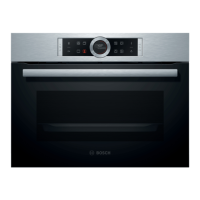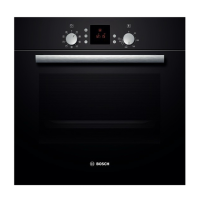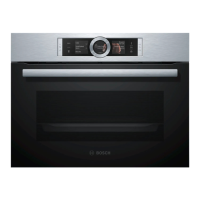NL Tested for you in our cooking studio.
To dry
Turn fruit and vegetables with a lot of moisture several
times. Release the dried food from the paper immediately
after drying.
With 4D hot air you can dry excellently. In this type of
preservation, flavorings are concentrated by
removing water.
Recommended setting values
Only use fruit, vegetables and herbs without defects
and wash them thoroughly. Line the roasting pan and
wire rack with parchment or parchment paper. Drain
the fruits well and dry them.
In the table you will find the settings for drying different
foodstuffs. Temperature and duration depend on the
type, humidity, maturity and thickness of the food to be
dried. The longer you let the food to be dried dry, the
better they are preserved. The thinner the cut, the faster
the end of the drying time is reached and the more
aromatic the dried food remains. That is why setting
ranges are specified.
Cut them into even sized pieces or thin slices. Place
unpeeled fruit on the dish with the cut sides up.
Make sure that both fruits and mushrooms are not
on top of each other.
Grate the vegetable and then blanch it. Drain the
blanched vegetables and spread them evenly on the
grid.
If you want to dry even more foodstuffs, please refer to
similar foodstuffs in the
Dry herbs with the stem. Place the herbs evenly in small
piles on the grid.
table.
Heating method used:
Use the following shelf heights for drying:
■ < 4D hot air
■ 1 grid: height 2
■ 2 grids: height 3+1
Fruit, vegetables and herbs To belong slide-in
height
confuse
ming culture in °C
method
Tempera- Length of time
in hours
Pome fruit (apple rings, 3 mm thick, 200 g
per grid)
Schedule 2 < 80 4-7
Stone fruits (plums) Schedule
Schedule
2
2
<
<
80
80
8-10
4-7Root vegetables (carrots), grated,
blanched
Sliced mushrooms
Herbs, cleaned
Schedule
1-2 Grids
2 <
<
60
60
6-8
2-6-
canning
Preparing fruits and vegetables
You can preserve fruits and vegetables in your appliance.
Only use fruit and vegetables without defects. Wash it
thoroughly.
:Warning – Risk of injury!
fruit or. vegetables, depending on the variety, peel, remove
the pits and finely chop and fill in preserving bottles up to
approx. 2 cm below the rim.
If the food is not properly cooked, the canning jars may
burst. Follow the instructions for boiling down.
Fruit
jars
Fill the fruit into the preserving bottles with hot, skimmed
sugar solution (approx. 400 ml for a 1-litre bottle). On one
liter of water:
■ approx. 250 g sugar with sweet fruit
■ approx. 500 g sugar with sour fruit
Only use clean and undamaged preserving
bottles. Only use heat-resistant, clean and
undamaged rubber sealing rings. Check clamps
and springs beforehand.
In a canning process, only use preserving bottles of the
same size and with the same foodstuffs. In the interior
you can preserve the contents of up to six preserving
bottles with , 1 or 1^ liter at the same time. Do not use
larger or taller pots. The lids could jump.
Vegetable
Fill the vegetables in the preserving bottles with
hot, boiled water.
Clean the glass edges. Place a wet rubber ring and lid
on each jar. Close the jars with clamps. Place the glass
jars in the roasting pan so that they do not touch. Pour
500 ml of hot water (approx. 80 °C) into the universal
pan. Set as shown in the table.
The preserving bottles must not come into contact with
each other during the boiling process in the interior.
46

